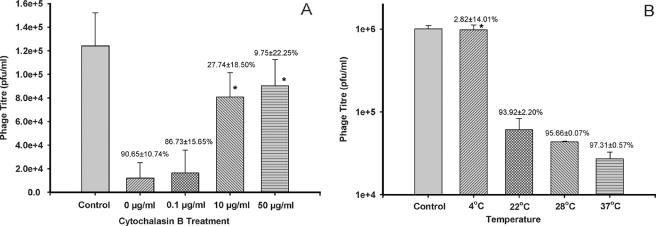FIG. 7.
Effect of cytochalasin B and temperature on removal of T4 by Tetrahymena. Coincubations of Tetrahymena cells and T4 phage were begun in Osterhout's solution with a known amount of T4 phage and allowed to proceed under different conditions for 24 h, at which time, cultures were centrifuged to remove the Tetrahymena cells and to permit measurement of the remaining virus as PFU. The mean PFU with standard deviation (n = 2 to 4) are plotted, with the percent decrease in PFU from time zero listed above the bars. The data were subjected to a Tukey-Kramer multiple comparisons test. (A) The coincubations were begun at 105 PFU and proceeded with cytochalasin B at 0.1, 10, or 50 μg/ml or without cytochalasin B (0 μg/ml). The control bar represents cell-free, phage-inoculated medium. Significant inhibition of phage inactivation occurred at 10 and 50 μg/ml of cytochalasin B, as determined by Tukey-Kramer multiple comparisons test (P < 0.05). (B) The coincubations were begun at 106 PFU and proceeded at 4°C, 22°C, 28°C, and 37°C. The control bar represents cell-free, phage-inoculated medium maintained at 4°C. Low temperature (4°C) was found to significantly inhibit phage inactivation, as determined by Tukey-Kramer multiple comparisons test (P < 0.05).

